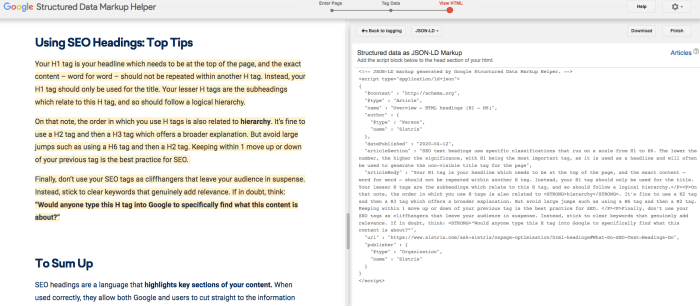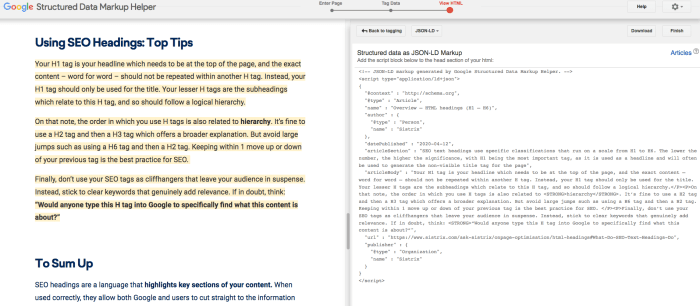Google structured data ranking sets the stage for optimizing your website’s visibility in search results. This in-depth exploration dives into the critical role structured data plays in enhancing your search engine rankings. We’ll cover everything from understanding the various markup formats like Schema.org to troubleshooting common implementation errors. Learn how to leverage structured data for rich snippets, knowledge graphs, and ultimately, improved organic search results.
We’ll analyze how search engines interpret structured data, showcasing its impact on search result display and click-through rates. We’ll delve into best practices, common pitfalls, and advanced strategies to maximize the effectiveness of your structured data implementation. Finally, we’ll discuss the vital connection between structured data and technical , highlighting how proper implementation can boost crawlability and indexing.
Implementing Structured Data for Google Rankings: Google Structured Data Ranking
Structured data markup, a crucial element for search engine optimization, helps search engines understand the content on your website better. By providing a clear, structured representation of your data, you enhance the chances of your website appearing in relevant search results. This improves visibility and potentially attracts more organic traffic.Implementing structured data involves providing clear semantic meaning to your content, making it easier for search engines to interpret and display.
This leads to more accurate search results and potentially more visibility in rich snippets and knowledge graphs. The right implementation can significantly impact your website’s organic search rankings, making it a valuable technique.
Methods for Implementing Structured Data
Implementing structured data involves using standardized vocabulary, such as schema.org, to define the type of data on your website. You can achieve this using various methods, including:
- Microdata: A simple method involving adding attributes directly within HTML elements. This approach is easy to understand and implement for smaller websites or when dealing with simple data structures. However, it can become complex for intricate data models. It requires direct modification of the HTML code, which can impact maintainability if not done meticulously.
- RDFa: A more robust method that uses attributes to link data to external vocabularies, such as schema.org. This method offers flexibility and scalability for larger websites with complex data. It allows for detailed descriptions and relationships between data points. However, understanding and applying the syntax correctly is critical for accurate interpretation by search engines.
- JSON-LD: This approach uses JavaScript Object Notation for Linking Data, allowing for structured data to be embedded directly within the HTML document. JSON-LD offers a clean and easily readable format. It’s highly versatile, making it suitable for complex websites and large datasets. Implementing it might require more technical expertise.
Best Practices for Using Structured Data Markup
Adhering to best practices is essential for optimal results. It ensures your structured data is correctly interpreted and displayed in search results. Key best practices include:
- Using a standardized vocabulary like schema.org: Schema.org provides a common language that search engines understand, ensuring accurate interpretation. Using schema.org vocabulary for your data is vital to avoid inconsistencies in how search engines understand your data.
- Validating your markup: Tools are available to validate your structured data markup, ensuring it adheres to the standards and avoids common errors. Validation helps catch syntax issues early on, improving the accuracy and consistency of your data representation.
- Testing your implementation: Testing your structured data implementation is crucial. Tools and methods for testing are readily available to confirm that your implementation accurately reflects your website’s data.
- Maintaining consistency: Maintaining consistent structured data markup across your website is critical for maintaining a high-quality strategy. Consistency ensures that search engines consistently understand your data and its relationships.
Impact of Correct Structured Data Implementation on Organic Search Results
Correct structured data implementation can significantly enhance your website’s visibility in organic search results. It allows search engines to better understand the context and meaning of your content, leading to higher rankings for relevant searches. This increased visibility leads to more organic traffic and potentially a better return on investment.
Role of Structured Data in Rich Snippets and Knowledge Graphs
Structured data plays a crucial role in rich snippets and knowledge graphs. Rich snippets provide visually appealing information directly in search results, often enhancing click-through rates. Knowledge graphs allow search engines to create interconnected relationships between entities, providing a more comprehensive understanding of the subject matter.
Comparison of Structured Data Implementations
The choice of implementation method depends on factors like website size, complexity, and technical expertise. Each method has its own advantages and disadvantages.
| Method | Pros | Cons |
|---|---|---|
| Microdata | Easy to learn and implement, suitable for smaller websites | Can become complex for large websites with intricate data structures |
| RDFa | Flexible and scalable for larger websites, supports complex data models | Requires more technical expertise to understand and implement correctly |
| JSON-LD | Clear and readable format, highly versatile for complex websites and large datasets | May require more technical expertise for implementation |
Structured Data and Search Results
Structured data is a crucial element in how search engines understand and display information. By providing a clear, machine-readable format, businesses and content creators can enhance the presentation of their data in search results. This, in turn, can significantly impact click-through rates and visibility.Search engines use structured data to interpret and organize the information presented in a website’s content.
This interpretation allows search engines to present this data in a more informative way to users, a process commonly known as rich snippets. This improves user experience by providing a quick overview of the information available, directly in the search results page.
Search Engine Interpretation of Structured Data
Search engines utilize structured data markup, such as schema.org vocabulary, to understand the context and meaning of the data on a webpage. This markup provides a standardized way for webmasters to tell search engines what type of information is on a particular page. For example, if a page describes a product, the markup will identify it as a product and include details like price, availability, and star ratings.
This allows search engines to extract specific data points, and present them to users in a structured manner.
Rich Snippets and Their Impact
Rich snippets are enhanced search results that include additional information beyond the standard title and description. This additional information, often pulled directly from structured data markup, can include images, star ratings, prices, and other relevant details. For example, a search for “Italian restaurants near me” might display rich snippets that include restaurant names, addresses, star ratings, and even photos, all sourced from structured data on the restaurant’s website.
Impact on Click-Through Rates
Rich snippets often lead to increased click-through rates. Users are more likely to click on search results that provide a clear overview of the information they’re looking for. Visual elements and readily available data points within the snippet can make the result more appealing and trustworthy, prompting a higher click-through rate compared to results without rich snippets. This, in turn, can improve the overall visibility and discoverability of a website.
Factors Influencing Visibility in Search Results
Several factors influence the visibility of structured data in search results. The accuracy and completeness of the structured data markup are crucial. Incomplete or inaccurate data may not be displayed, or might be displayed incorrectly. The relevance of the data to the user’s search query is another key factor. Search engines prioritize data that directly addresses the user’s search terms.
Importance for Search Engine Rankings
Structured data can significantly improve search engine rankings. While not a direct ranking factor, it enhances the search experience for users, which can indirectly contribute to higher rankings. Providing clear and accurate structured data improves the search engine’s understanding of a page’s content, which in turn may lead to higher rankings.
Different Implementations and Their Results
Different structured data implementations can lead to varied results. A meticulously implemented and accurate schema markup will typically result in rich snippets that are comprehensive and helpful to users. Conversely, poor or incomplete implementations may result in no rich snippets being displayed, or snippets that are misleading or inaccurate. This highlights the importance of precision in structured data implementation.
Optimizing your Google structured data is crucial for search engine visibility. Understanding how search engines interpret data is key, and this directly relates to a successful entrepreneurial mindset. For instance, developing a strong understanding of the “perfect entrepreneurial attitude according to science” perfect entrepreneurial attitude according science can help you craft compelling content that resonates with search algorithms, ultimately improving your rankings.
Ultimately, mastering structured data is a powerful tool in the entrepreneurial arsenal.
Table Illustrating Differences
| Structured Data | Search Result |
|---|---|
| Correctly implemented schema markup for a restaurant, including name, address, photos, and ratings. | Rich snippet with name, address, star rating, photos, and a “view menu” button. |
| Incomplete schema markup for a product, missing price and availability. | Basic search result, no rich snippet. |
| Incorrect schema markup, misrepresenting product type. | Rich snippet showing incorrect product information. |
Troubleshooting Structured Data Issues
Implementing structured data is crucial for search engine optimization, but errors can hinder your efforts. This section delves into common problems, diagnostic steps, and tools to resolve them effectively. Proper structured data implementation is vital for Google to understand your content’s context and display it accurately in search results.Troubleshooting structured data errors is an iterative process, requiring careful analysis and refinement.
By systematically identifying and addressing issues, you can ensure your structured data is correctly interpreted by search engines, leading to improved visibility and rankings.
Common Structured Data Implementation Errors
Understanding common mistakes is the first step in effective troubleshooting. Incorrect schema markup, missing or mismatched properties, and inconsistencies in data formatting are frequent causes of errors. These problems can stem from misinterpreting schema specifications or failing to adhere to Google’s structured data guidelines. Recognizing these patterns helps pinpoint the source of the issue, leading to more targeted solutions.
- Incorrect Schema Markup: Using the wrong schema.org vocabulary or incorrectly applying the selected schema markup can result in invalid data. Carefully verify the schema used against the schema.org specifications.
- Missing or Mismatched Properties: Essential properties within the structured data may be missing or incorrectly matched to the schema. Verify that all required properties are present and correctly formatted, avoiding mismatches.
- Data Inconsistencies: Inconsistent formatting of data values (e.g., incorrect date formats, missing values) can cause issues. Ensure data values adhere to the defined schema specifications, checking for uniformity.
- Incorrect Data Types: Using incorrect data types (e.g., string instead of integer) can lead to validation errors. Precisely match data types as defined by the schema.org specifications.
Diagnosing and Resolving Structured Data Issues
Effective diagnosis requires methodical steps. Begin by carefully examining your structured data markup. Ensure it adheres to schema.org specifications, avoiding common mistakes. Use validation tools to pinpoint errors, then correct any identified problems in your code.
- Examine Markup Carefully: Review the structured data markup within your website’s HTML code for any obvious errors in formatting, missing properties, or incorrect data types. This is the first step in diagnosing the problem.
- Utilize Validation Tools: Schema.org provides tools to validate your structured data. These tools identify syntax and formatting issues that may not be immediately apparent during manual inspection. This step helps to avoid manual errors.
- Inspect Google Search Console: Google Search Console offers valuable insights into structured data issues found by Google’s crawlers. Review any reported errors to understand the specific problems encountered by Google’s systems. This will help to identify specific issues that affect how Google interprets your site.
- Correct Errors and Retest: After identifying and correcting the errors, revalidate your structured data using the tools mentioned previously. Thorough testing ensures that the corrections have resolved the issues and that your structured data adheres to schema.org specifications. This iterative process is key to resolving errors.
Using Google Search Console for Error Identification
Google Search Console provides valuable insights into how search engines are interpreting your structured data. This tool identifies crawl errors and warnings, pinpointing specific problems in your markup. Regularly monitoring Search Console helps to identify and address structured data issues promptly.
- Structured Data Testing Tools: Google Search Console offers a structured data testing tool. This tool allows you to test and validate your structured data, providing valuable feedback on its correctness. This tool is very important for identifying errors in your structured data implementation.
- Error Messages and Solutions: Review error messages from Google Search Console to pinpoint the specific issue. Different error messages correspond to different types of issues. Refer to Google’s documentation for solutions based on the specific errors reported.
Using Validation Tools to Ensure Correctness
Validation tools are crucial for ensuring the correctness of your structured data. These tools check the syntax, structure, and properties against schema.org specifications, providing detailed error reports. This helps to prevent issues that could hinder your site’s performance in search results.
Google structured data ranking is crucial for SEO, but understanding how user behavior translates into data is key. This often involves digging into granular data like GA4 snapshot templates, specifically the aggregate identifiers within them, to get a clearer picture of user journeys. Learning how to utilize ga4 snapshot templates aggregate identifiers can give you valuable insights into what users are actually doing on your site, which in turn helps refine your structured data implementation for optimal search visibility.
Ultimately, strong structured data implementations combined with a deep understanding of user behavior via GA4 data is the most effective way to improve rankings.
- Schema.org Validation Tools: Several online tools validate structured data against schema.org specifications. These tools check for syntax errors, missing properties, and data type issues, identifying areas that need correction.
- Third-Party Validation Tools: Consider utilizing third-party validation tools that can provide detailed reports. These tools may offer advanced features beyond basic schema validation, ensuring a thorough assessment of your structured data implementation.
Detailed List of Error Messages and Solutions, Google structured data ranking
A comprehensive list of structured data error messages and corresponding solutions is essential for troubleshooting. Each error message points to a specific problem in your implementation. Addressing these issues directly enhances your site’s performance in search results.
Understanding Google’s structured data ranking is crucial for any startup’s SEO strategy. Knowing how to optimize your site for these specific formats can significantly improve your search engine visibility. To ensure your startup is targeting the right market, conducting thorough market research is equally important, which you can explore further at market research for startups. This research will help you identify your ideal customer and tailor your content to their needs, ultimately boosting your Google structured data ranking even more.
| Error Message | Possible Cause | Solution |
|---|---|---|
| Invalid Property Value | Incorrect data type or format | Ensure data type and format match schema.org specifications. |
| Missing Property | Essential property omitted | Add the required property with correct data type and format. |
| Duplicate Property | Redundant property | Remove the duplicate property to avoid conflicts. |
Step-by-Step Guide for Fixing Structured Data Implementation Problems
This guide provides a systematic approach to fixing structured data implementation issues. Follow these steps to diagnose and resolve problems effectively.
- Identify the error message or issue using tools like Google Search Console.
- Analyze the affected structured data markup to pinpoint the exact problem area.
- Correct the errors in your structured data markup based on schema.org specifications.
- Re-validate your markup using schema validation tools to confirm correction.
- Monitor Google Search Console for continued success.
Advanced Structured Data Strategies
Structured data isn’t just about adding tags to your website; it’s about crafting a more meaningful experience for both search engines and users. Advanced strategies leverage this markup to enhance search visibility, improve site usability, and ultimately, boost user engagement. This involves a deeper understanding of how search engines interpret and use structured data, as well as how it can be employed to create a better overall user experience.Understanding the intricacies of structured data allows for more nuanced optimization strategies, moving beyond basic implementation to achieve truly impactful results.
This goes beyond simply marking up content; it’s about strategically using the markup to align with user intent and deliver a more informative and valuable experience.
Enhancing Rich Results
Rich results go beyond basic search results, offering enhanced visual displays that include images, prices, reviews, and more. This improves user engagement and click-through rates, directly impacting organic search performance. Strategic use of structured data is crucial in obtaining rich results. Schema.org provides a standardized way to define and structure your data, enabling search engines to better understand the content and potentially display it in rich result formats.
Examples include product listings with prices and images, recipes with ingredients and preparation instructions, and events with dates, times, and locations.
Improving Site Navigation and Usability
Structured data can be employed to improve website navigation and usability by enabling search engines to understand the relationships between different pages. This can improve the overall user experience, leading to higher engagement and reduced bounce rates. Implementing structured data for site navigation, like using schema.org’s BreadcrumbList markup, provides context and enhances site hierarchy. This directly contributes to the clarity and comprehensibility of the site’s structure for both users and search engines.
Boosting User Experience
Structured data contributes to a better user experience by making search results more informative and user-friendly. Users can quickly identify the relevant information they need, saving time and improving satisfaction. By implementing structured data for events, for example, search engines can display the date, time, location, and description of the event in search results. This detailed information allows users to easily find and access the information they are looking for.
Improving Content Discoverability
Structured data can be leveraged to enhance content discoverability by using schema markup to add context and detail to various types of content. This allows search engines to better understand the content and categorize it appropriately. For example, marking up articles with schema.org’s Article markup can provide details such as author, publication date, and topics, making it easier for users to discover relevant content.
Creative and Innovative Applications
Beyond the typical uses, there are creative applications of structured data that can enhance rankings. Using schema.org’s “HowTo” markup to structure a tutorial can provide step-by-step instructions, making the content more engaging and valuable to users. Implementing schema.org’s “FAQ” markup allows for direct answers to common questions, further enhancing user experience and improving search rankings.
Structured Data and Technical

Structured data isn’t just about enhancing search results; it’s a powerful tool for improving a website’s technical . By providing a clear and organized representation of content, structured data makes websites easier for search engine crawlers to understand and interpret. This, in turn, leads to better rankings and increased visibility in search results.Integrating structured data effectively with other technical strategies can significantly boost a website’s performance in search engine results pages (SERPs).
This synergistic approach ensures that search engines have the necessary information to properly understand and index content, ultimately leading to improved organic traffic and conversions.
Relationship between Structured Data and Technical
Structured data and technical are deeply intertwined. Structured data provides the explicit, machine-readable information that search engines need to understand the content of a webpage, while technical focuses on ensuring that search engines can easily crawl, index, and understand the website’s architecture. This combination enhances search engine crawlability, indexing, and ultimately, ranking. Structured data, when correctly implemented, helps search engines understand the context and meaning of webpages, leading to improved search results.
Structured Data and Website Crawlability
Structured data plays a vital role in website crawlability. By providing clear and organized data, structured data markup helps search engine crawlers understand the content of a webpage more easily. This improved understanding facilitates efficient crawling, enabling search engines to quickly and accurately index the content. This increased crawlability can significantly improve a website’s search engine visibility.
Structured Data and Website Indexing
Structured data directly impacts website indexing by providing search engines with a clear and organized representation of content. This allows search engines to accurately interpret and categorize content, ensuring that it is indexed correctly and displayed appropriately in search results. Structured data is a valuable tool for improving a website’s searchability and overall visibility. Correctly implemented structured data helps search engines understand the content better, leading to better indexing and potentially higher rankings.
Structured Data and Site Performance
The impact of structured data on site performance is indirect but significant. By improving crawlability and indexing, structured data can contribute to improved site performance. Faster indexing translates to quicker loading times, as the content is already pre-indexed. However, it’s crucial to remember that structured data itself does not directly impact page load speed. Optimizing for site performance remains a separate technical concern.
The combination of these factors, however, often leads to a positive impact on site performance.
Optimizing Structured Data for Search Engines
Optimizing structured data for search engines involves several key steps:
- Validating structured data markup: Use tools like Google’s Structured Data Testing Tool to ensure the markup is valid and conforms to the schema.org standards. This validation helps ensure the data is easily understood by search engines.
- Implementing schema.org vocabulary: Choose the correct schema.org vocabulary to describe the content of your website. Using the appropriate vocabulary is essential for search engines to understand the context and meaning of your content. Careful selection of vocabulary helps to avoid confusion and misinterpretation by search engines.
- Testing and monitoring structured data: Regularly test the implementation of structured data to identify and fix any issues. Monitoring structured data helps ensure its effectiveness in improving search engine visibility.
- Staying updated on best practices: Search engine algorithms and best practices evolve. Keeping abreast of updates in structured data guidelines ensures that the markup remains effective and compliant.
Last Recap

In conclusion, mastering Google structured data ranking is paramount for any website aiming for top search engine rankings. By understanding the fundamentals, implementing best practices, and troubleshooting potential issues, you can significantly improve your website’s visibility and attract more qualified organic traffic. This comprehensive guide equips you with the knowledge and tools to successfully navigate the complexities of structured data and unlock its potential for boosting your strategy.






